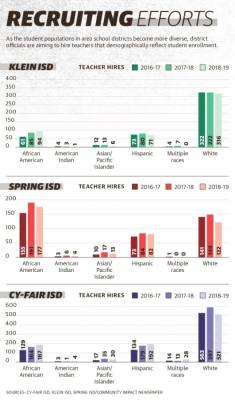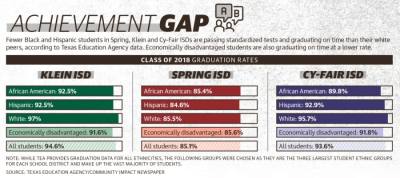In the 2003-04 school year, white students made up more than 50% of students at KISD and CFISD and more than 30% of SISD students, while white teachers accounted for more than 80% of all teachers at each of the three school districts, according to Texas Education Agency data.
Fifteen years later, the white student populations at the school districts had dropped to 31.3% in KISD, 24.1% in CFISD and 7.5% in SISD in the 2018-19 school year, but white teachers still accounted for 71.9%, 66.4% and 35.2% of all teachers in KISD, CFISD and SISD, respectively.
“I believe that the Klein Family has always been a community that strives for inclusivity; however, I recognize that as a leader, confronting injustice and racism and prejudice of all kinds starts with looking in the mirror,” KISD Superintendent Jenny McGown said in an email.
Statewide in 2018-19, 11% of teachers were Black, 28% Hispanic and 58% white, but 13% of students were Black, 53% Hispanic and 27% white, according to the TEA. Comparatively, KISD and CFISD each have less diverse teaching staffs compared with the state average, while SISD has a more diverse teaching staff.
Within the same time span, each of the school districts’ economically disadvantaged populations—or students who are eligible for free or reduced-price meals under the national School Lunch and Child Nutrition Program—have nearly doubled across all three school districts.
To keep up with these changing demographics and varying needs, SISD, KISD and CFISD officials are pushing for more diverse teacher hires while launching equity initiatives and seeking legislative support.
“The injustice, racism and prejudice that is so clearly evident in the world today is a heavy burden that our students must bear, and as educators, it’s essential that we help them carry this weight,” McGown said.
Achievement gap
According to TEA data, local Black and Hispanic students are passing standardized tests and graduating on time at a lower rate than their white counterparts, although officials said they believe this achievement gap may correlate with poverty rates more than demographics.
Andrea Chevalier, a lobbyist with the Association of Texas Professional Educators, said the correlation between test scores and poverty is one seen across the state, but there is typically a similar correlation between poverty and demographics.
“It’s not that those students are less capable of learning,” she said. “There are other things happening around them, other struggles in their lives—maybe there’s food insecurity, housing insecurity—things that are causing them to struggle academically.”
In 2018, while 85%-95% of white students across the three school districts graduated on time, only 84%-92% of Hispanic students and 85%-89% of Black students graduated on time, according to TEA data. At the same time, 1%-3% fewer economically disadvantaged students graduated on time than their non-economically disadvantaged peers.
In 2019, 88% and 91% of white KISD students in third to eighth grades passed the State of Texas Assessments of Academic Readiness in reading and math, respectively. Meanwhile, 72% and 81% of Hispanic students and 68% and 76% of Black students passed the reading and math tests, respectively.
The same trends can be seen in both SISD and CFISD, as 5%-18% fewer Black and Hispanic students are passing standardized tests than their white peers in SISD and 10%-18% fewer in CFISD.
However, district officials said they believe a student’s economic status is a more significant factor than race and ethnicity. Across each of the three school districts, 1%-10% fewer economically disadvantaged students are passing standardized tests than the total student population, according to TEA data.
Tracking teachers
Diverse teacher representation can positively affect student outcomes and better set them up for future success, said Laura Owen, who serves as the director of the Center for Postsecondary Readiness and Success as well as a research associate professor at American University. CPRS conducts research and offers professional development opportunities that aim to improve postsecondary opportunities for students who are historically disenfranchised and underrepresented on college campuses.
A 2017 study from the IZA Institute of Labor Economics found Black males from low-income families who had at least one Black teacher in third to fifth grade were 39% less likely to drop out of high school and 29% more likely to pursue a four-year degree.
“We know that if our minority students have at least one same-race teacher, ... they do better on standardized tests; they have better attendance; they’re suspended less frequently,” Owen said. “If we do not have teachers of color who are on our staff who are working with our students, then we miss opportunities to question assumptions that we make about race and privilege.”
Similarly, according to the Learning Policy Institute—a nonprofit that conducts independent research to improve education policy and practice—teachers of color boost the academic performance of students of color, including reading and math test scores, graduation rates and aspirations to attend college.
CFISD officials have managed to hire more teachers of color in recent years—from 297 teachers in 2016-17 to 441 in 2018-19—and said their goal is to recruit diverse educators who reflect student demographics.
SISD officials said their primary goal in recruitment, selection and hiring is to obtain the most highly qualified employees to educate students, regardless of ethnicity. Despite this, the district hired 34 more teachers of color and 19 fewer white teachers in 2018-19 than it had two years prior. Likewise, KISD hired 172 teachers of color in 2018-19, compared with 154 hired in 2016-17.
However, Chevalier said just hiring more diverse teachers is not the sole answer for producing more successful students, as training also plays a pivotal role in removing implicit bias.
“A challenge is more so for the adults to remember that the world that we grew up in is not the world that exists now, and so they need to still be willing to change the way that they think,” she said. “Changing adult behavior is pretty hard. It takes a lot of ... professional development and a lot of uncomfortable situations, especially when you’re talking about race.”
Similarly, the Citywide Implicit Bias Project—a Houston-based initiative designed to address the overrepresentation of students of color in school disciplinary systems—also recommends school districts establish districtwide equity policies and hold mandatory implicit bias training for all educators.
“It is really important that a population of any identity isn’t being left behind in particular in academics,” said Marcus Ceniceros, one of the leaders of the project.
New initiatives
To reinforce this sentiment, district officials have recently made strides in the pursuit of equity.
The SISD board of trustees approved three new legislative priorities for the 2020-21 school year during its Sept. 8 meeting, among which was the promotion of cultural awareness and diversity through adequate training for school districts statewide.
“We just feel that this is an issue whose time has come and that we all need to get behind it, and we need to push it at local and state levels,” said Deborah Jensen, SISD trustee and the board vice president, during the Sept. 8 meeting.
Additionally, SISD launched a five-year equity initiative in late June, which calls for the formation of an Equity Action Plan Committee made up of district officials, community members, students, teachers and parents. The committee will be tasked with establishing the equity action plan’s priority focus areas and identifying the priority data points for an upcoming equity audit, which will be conducted by an outside partner.
According to Lupita Hinojosa, SISD’s chief of innovation and equity, the audit will assist the district in determining opportunity gaps in several areas, such as school funding, teacher quality and diversity, school leadership quality and diversity, and district policies and procedures.
“We believe that this thorough audit will help us identify opportunity gaps and barriers to student success,” Hinojosa said.
The KISD board of trustees also passed a resolution at its July 13 board meeting reaffirming the district’s commitment to its “every student counts” initiative, reinforcing the importance of ensuring every student’s success, regardless of ethnicity or socioeconomic status. McGown said this initiative, combined with student-led programs like Culture4Caring and Leadership Academy, led by the KISD Police Department, are instrumental in creating an inclusive community.
“We have a shared vision in Klein ISD that focuses on the promise and purpose of every student in our care,” McGown said. “Equity and cultural responsiveness is embedded in our guiding documents and actions. They are pivotal in making this aspirational vision a reality for our students.”
CFISD officials also launched a committee over the summer designed to evaluate the equity of academic opportunity, representation in hiring and student discipline measures throughout the district. CFISD’s board also plans to consult with an outside group to conduct an equity audit and develop a plan to address issues in these areas districtwide.
District trustees also drafted a resolution condemning racism, which was signed by all trustees Sept. 14.
“Providing diverse environments prepares our students for the diverse global roles they will have as leaders,” said Deborah Stewart, CFISD’s chief of employee and student services.







